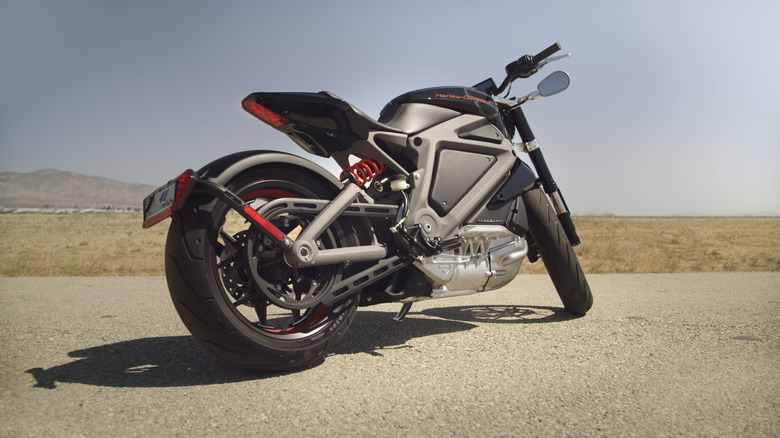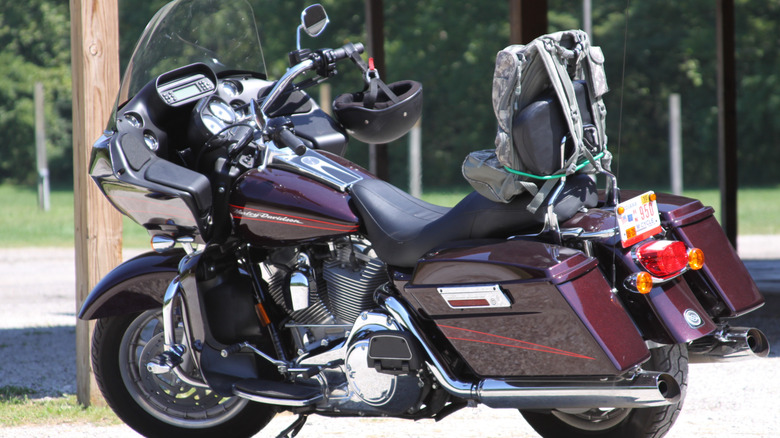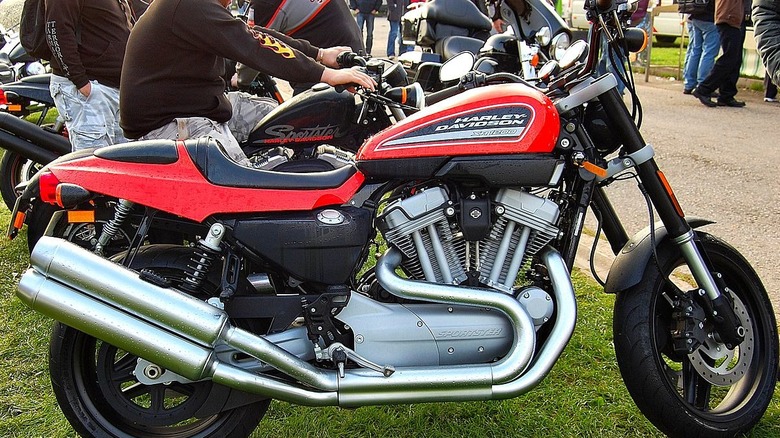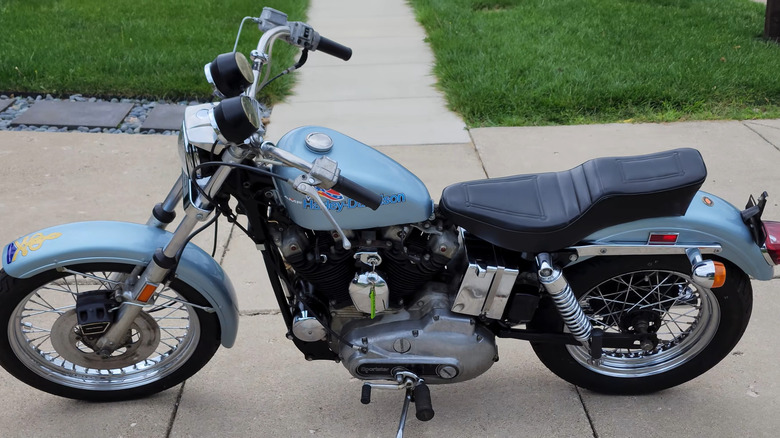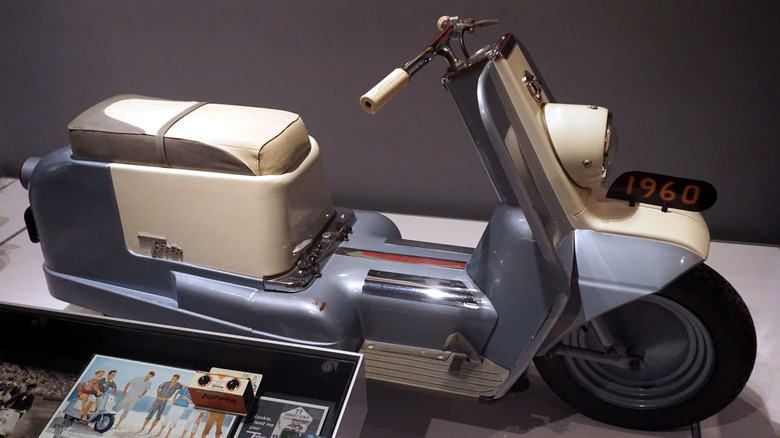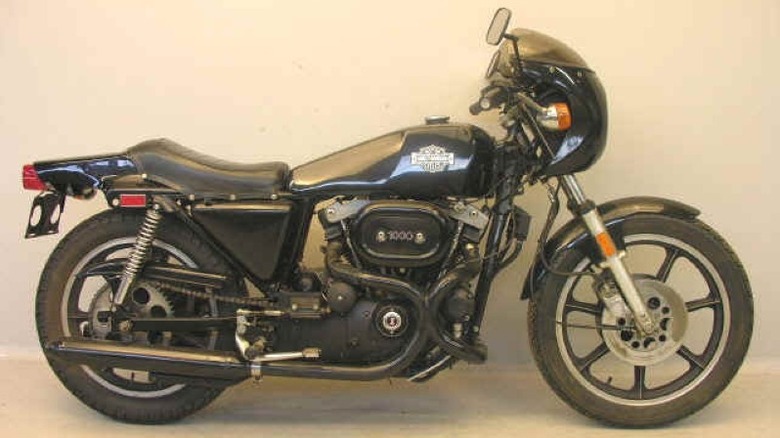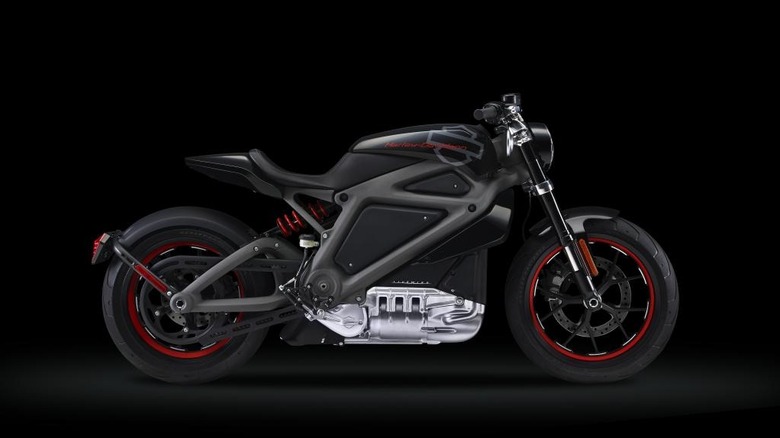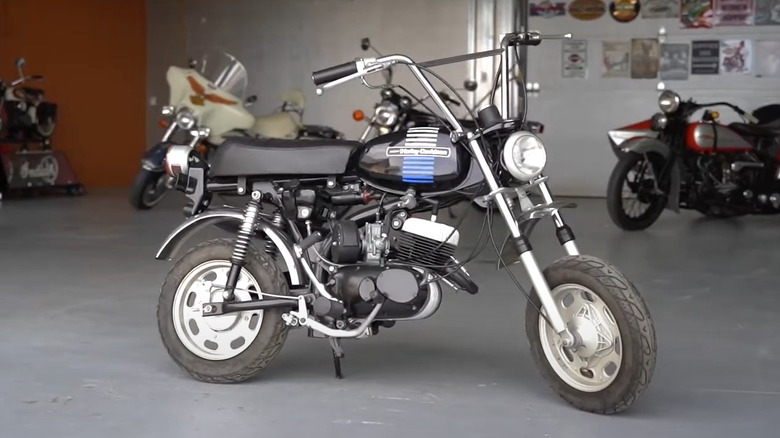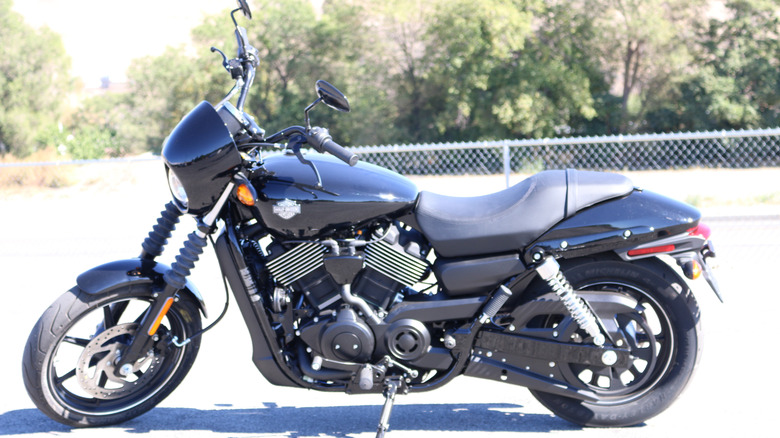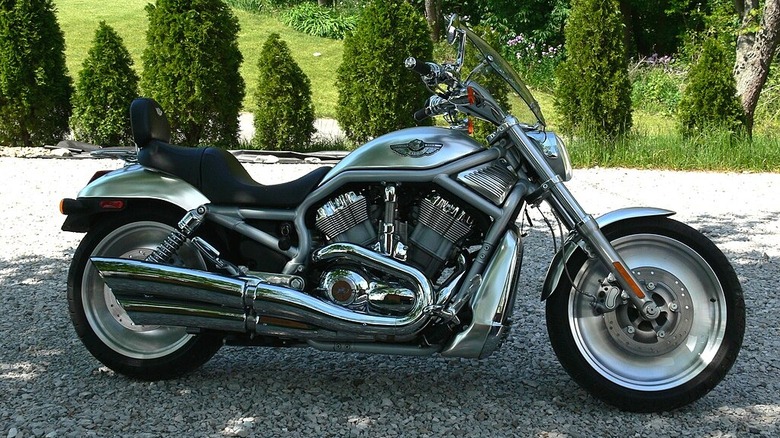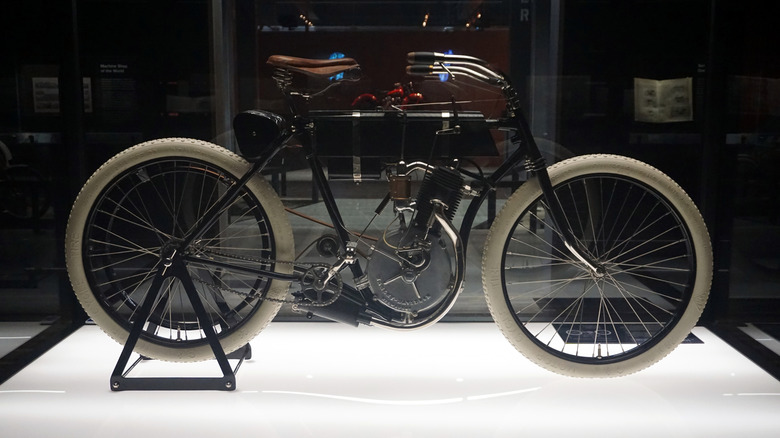10 Of The Worst-Looking Harley-Davidson Motorcycles Ever Designed
When you think of American motorcycle culture, the first name that comes to mind is Harley-Davidson. That's actually two names, those of William S. Harley and Arthur Davidson, but who's counting? The point is, Harley-Davidson and its iconic motorbikes are a central part of Americana, and the image of a leather-clad biker burning rubber on a wide-open highway is as American as a game of baseball or mama's apple pie.
Over the years, Harley-Davidson has created countless legendary bikes, including some of the most instantly recognizable vehicles in the history of automotive travel. However, they can't all be winners. Sometimes, despite the best of intentions, Harley-Davidson's engineers and designers put out some truly ugly motorcycles. For this list, we're judging Harley-Davidson's ugliest vehicles purely on their aesthetic merit, or lack thereof. Whether or not they were commercially successful or well-made bikes is not a factor in their inclusion here. All that matters is that we chose the ugliest rides we could find from Harley-Davidson's 120-year history. Without further ado, here are SlashGear's picks for 10 of the worst-looking Harley-Davidson motorcycles ever designed.
2009 Road Glide
How big should a motorcycle be? We don't know the exact answer to that question, but we know one thing: The 2009 Road Glide was too big. How big is it? It's so big, it might as well be a car. It's not a low-riding hog, but it's certainly not a zippy crotch rocket, either. It's the SUV of motorcycles, and that's not a compliment.
The Road Glide is something of a perennial non-favorite for SlashGear, having appeared on our 2024 list of The Five Worst Motorcycles In The History Of Harley-Davidson, and its engine appeared on the same year's list, 10 Of The Biggest Motorcycle Engines Ever Made. That last one makes sense, since you would need a mammoth engine just to move this 800-pound beast, and that's not including the additional weight of a driver and passenger, which can easily add another 400 or 500 pounds to the total haul being pushed by the engine.
XR1200
Harley-Davidson is the spirit of America in the form of a motorcycle. If that's the case, then why does the XR1200 look like a European import with a Harley-Davidson sticker glued on? This is the bike that a Harley-Davidson designer would conceptualize after they spent a year abroad and returned home with an inexplicable, vaguely European accent. Like that hypothetical designer, the XR1200 is an American pretending to be European, and it's not a good look.
Despite the XR1200's delusions of European grandeur, it's still a Harley-Davidson product, but the only evidence of that fact is the Harley-Davidson labeling. Aside from the V-twin engine sticking out of the side, there's little in the way of chrome tubing or stylish exhaust pipes to admire, giving the motorcycle the appearance of an electric bike with exhaust pipes. Harley-Davidson is as American as it can get, so why try to pretend to be something it isn't? Let the Europeans make their own bikes. If it's a Harley-Davidson, it's got to look like one.
1977 Confederate Edition
In 1976, Harley-Davidson released the Liberty Edition, an aesthetic upgrade of its Super Glide and Electra Glide models. Intended to mark the passing of America's bicentennial, the bike featured striking graphics that celebrated America in time for her 200th birthday.
One year later, Harley-Davidson tried again, this time with the Confederate Edition, and ... you can probably see the problem. Not to get political or anything, but the Confederate States of America infamously fought a war against the United States, resulting in the deaths of 620,000 Americans. Needless to say, the idea of a Harley-Davidson motorbike celebrating the Confederacy was controversial and sold poorly. As a result, only 23 units are known to have survived to the present day.
Aside from the political ballyhoo, the Confederate Edition simply wasn't an interesting design. The silver paint job was presumably meant to evoke the gray uniforms of Confederate soldiers, but the additional Confederate flag details were small and underwhelming, especially when compared to the Liberty Edition's beautiful designs. Today, Harley-Davidson's Confederate edition, like the Confederacy itself, is a footnote in history best left to the past.
Topper
In America, we have motorcycles. In Europe, they have scooters. Okay, that's an unfair generalization, but it's also not inaccurate. In 1960, presumably to get in on the lucrative scooter trend, Harley-Davidson introduced the Topper, its version of a cute little scooter. Unfortunately, the result was completely unrecognizable as a Harley-Davidson product and was quietly discontinued after the 1965 model.
Sometimes, when a company reaches out to try something new, it discovers a whole new audience. Sometimes, it learns that it is better off staying in its lane, so to speak. It's hard to blame Harley-Davidson for trying something different, even if the result failed to break out.
Fun fact: The Harley Topper served as inspiration for the name of Sean "Topper" Harley, the character played by Charlie Sheen in the hit comedy film "Hot Shots!" and its sequel, "Hot Shots! Part Deux". Humorously, despite his American name and sensibilities, Harley drives a Honda XL 600 V Transalp motorcycle in the film.
XLCR Cafe Racer
The XLCR Cafe Racer is a tricky bike to pin down, since it's become a cult favorite in the nearly five decades since its 1977 debut. According to Slash Gear's own celebration of the XLCR, the bike was not a success when it was first released, and only around 3,000 units were ever produced. However, it was hugely influential and paved the way for other, more successful bikes to come.
Unfortunately, the XLCR's biggest weakness is its look. This bike looks like the remnants of a motorcycle that's been stripped for parts, with big holes in the design that you can see right through to the other side. The XLCR looks like a Terminator at the end of the movie, after most of its flesh has been blown away by gunfire and explosions, and you can see all the mechanical parts underneath. It's an efficient design, to be sure, but its overall look is small and fragile, far from the rough-and-ready sturdiness befitting a Harley-Davidson product.
2019 Project Livewire Electric Motorcycle
Harley-Davidson aims to go fully electric in the future. Hopefully, its future offerings will fare better than its first attempt at an electric vehicle, the LiveWire. First announced in 2014, the bike wouldn't become available to consumers until 2019. Even with all that R&D time, the LiveWire shipped with an outrageous price tag of $29,799, and even today, the more modern LiveWire models only have a range of 70 miles on an open highway, which is underwhelming, to say the least.
On top of all of these missteps, the LiveWire just didn't look cool. It looked more like a backyard grill station than a Harley-Davidson, with its superfluous black paneling and low-slung electric motor. In fact, without the Harley-Davidson branding, this bike would scarcely be recognizable as part of its fleet of two-wheel vehicles. The future is definitely electric, but if the LiveWire is any indication, that future for Harley is still quite a few years away.
1974 Z90
Another attempt by Harley-Davidson to appeal to the European market with a lightweight bike, the Z90, introduced in 1973, looks more like a modern day E-Bike than a Harley-Davidson motorcycle. The engine on this thing looks like an electric egg beater, and, by all accounts, the Z90's two-stroke engine was about as powerful. This mini-bike failed to impress and was phased out by 1975. It's good to try to branch out and appeal to a new market, but history has shown that Harley-Davidson just doesn't work when it veers too far away from its characteristic sensibilities.
There's a good reason why the Z90 barely resembles a Harley-Davidson, and that's because it's basically an Italian Aermacchi with some Harley-Davidson labeling stuck on. Harley-Davidson purchased 50% of Aermacchi back in 1960, and products like the Z90 were the result. Despite the underwhelming Z90, Harley-Davidson still went on to purchase the rest of the company in 1974. Apparently, Harley-Davidson regretted the purchase, and ultimately sold the company to Italian motorcycle company Cagiva in 1978.
2014 Street 750
In the modern era, Harley-Davidson is seen as kind of a throwback, an ode to the old days of cross-country highway travel, a free-spirited attitude shared by biker gangs and hippies, two groups that otherwise couldn't be more different. For better or worse, Harley-Davidson is, in a word, retro. As a result, it only made sense for the company to target young people in an effort to revitalize its image. Unfortunately, the 2014 Street 750 failed to make the brand hip and cool again.
It looks vaguely Harley-Davidson-esque, but its abundance of cheap plastic parts makes the Street look, well, cheap and plastic. This is the kind of bike an uninformed tech bro might buy because he doesn't know any better. It may look like a Harley-Davidson, but in practice, it's more of a fancy-looking scooter, lightweight and built for urban use, which is actually perfect for a tech type, come to think of it. If there are two lessons to be learned here, it's that there's nothing wrong with being a little old-fashioned, and that trend-chasing rarely ends well.
2001 V-Rod
On the surface, the Harley-Davidson V-Rod looks pretty good. It's got some nice chrome, a lovely silver paint job, some shiny chrome exhaust pipes, chrome engine detailing, and ... okay, that's way too much chrome. It's important for a Harley-Davidson to look tough and ready for the road, but the V-Rod looks like it's trying a little bit too hard. It looks like a retro-future throwback, like what a science-fiction writer from the 1970s thought motorcycles would look like in the far-flung future of 1999.
It's a real shame the V-Rod tried a bit too hard, since it didn't need to. By all accounts, the V-Rod is one heck of a bike, powered by one of SlashGear's favorite engines, a powerful four-stroke beast that could bring the bike to max speeds in excess of 140 MPH. However, with all that chrome, if the sun hits at the right angle, the reflection could cause a nearby motorist to go blind!
Harley Davidson Model No 1
The Harley that started it all, the Harley-Davidson Model No. 1, may not look like much, but its legacy lives on in every single Harley-Davidson made since its 1905 debut. Simply put, this is where it all began. Of course, just because it's old doesn't make it a classic, and while the Model No. 1 may have vast historical significance, it's not exactly a looker.
The Model No. 1 is basically a bicycle with a rubber band engine. It doesn't look comfortable, and the suspension is sparse, save for the small springs under the seat, though that hardly counts for much. The white tires are a nice touch, though. This original Harley-Davidson model cost $200 in 1903. Adjusted for inflation, that's well over $6,500 in 2025 money. Modern-day replicas of the bike sell for upwards of $245,000. That's quite a pretty penny, especially for a bike with a maximum speed of only 40 MPH.
